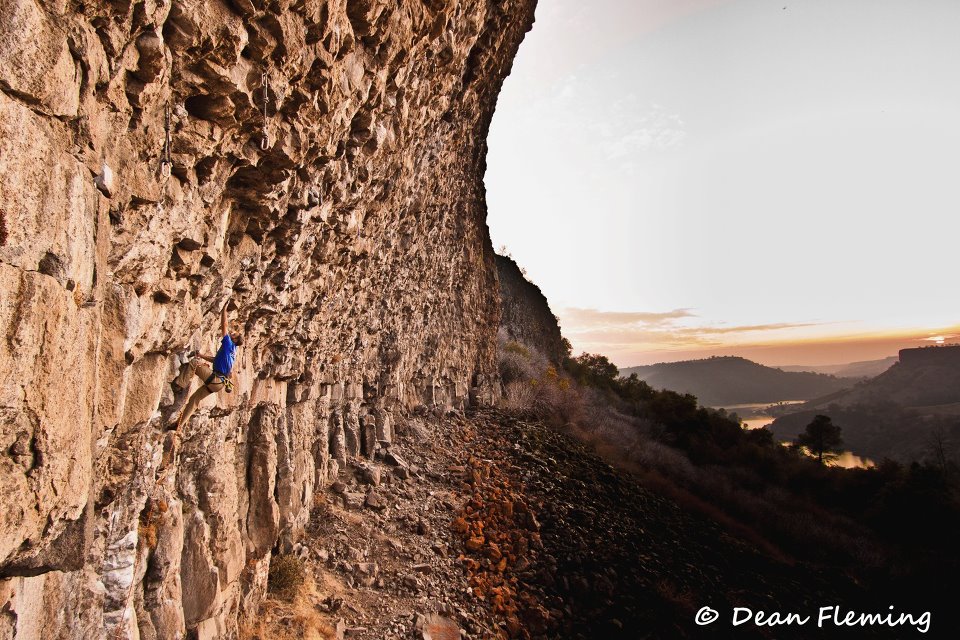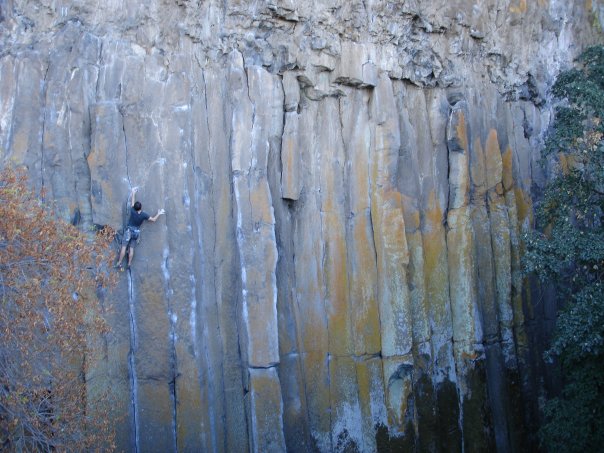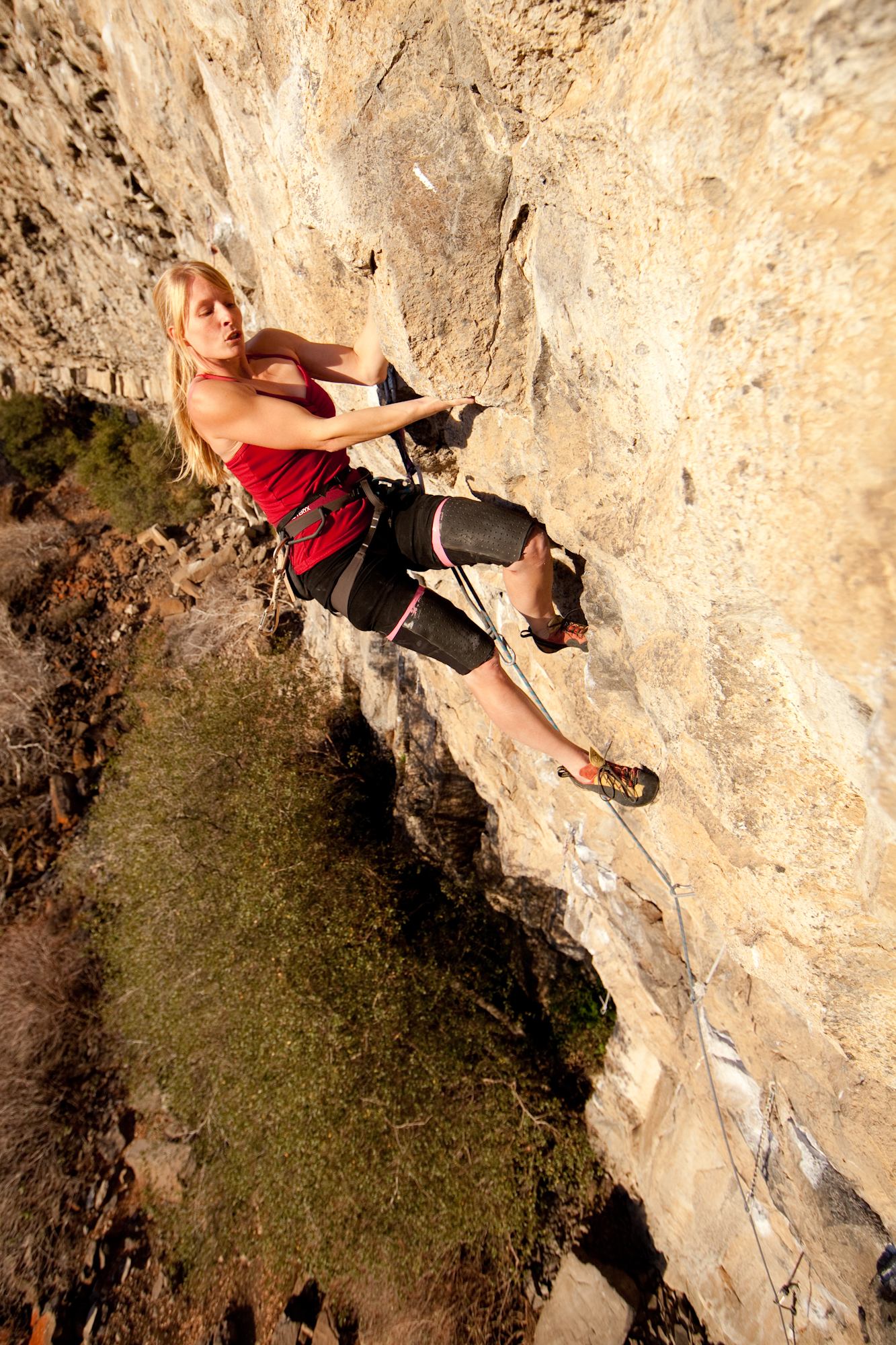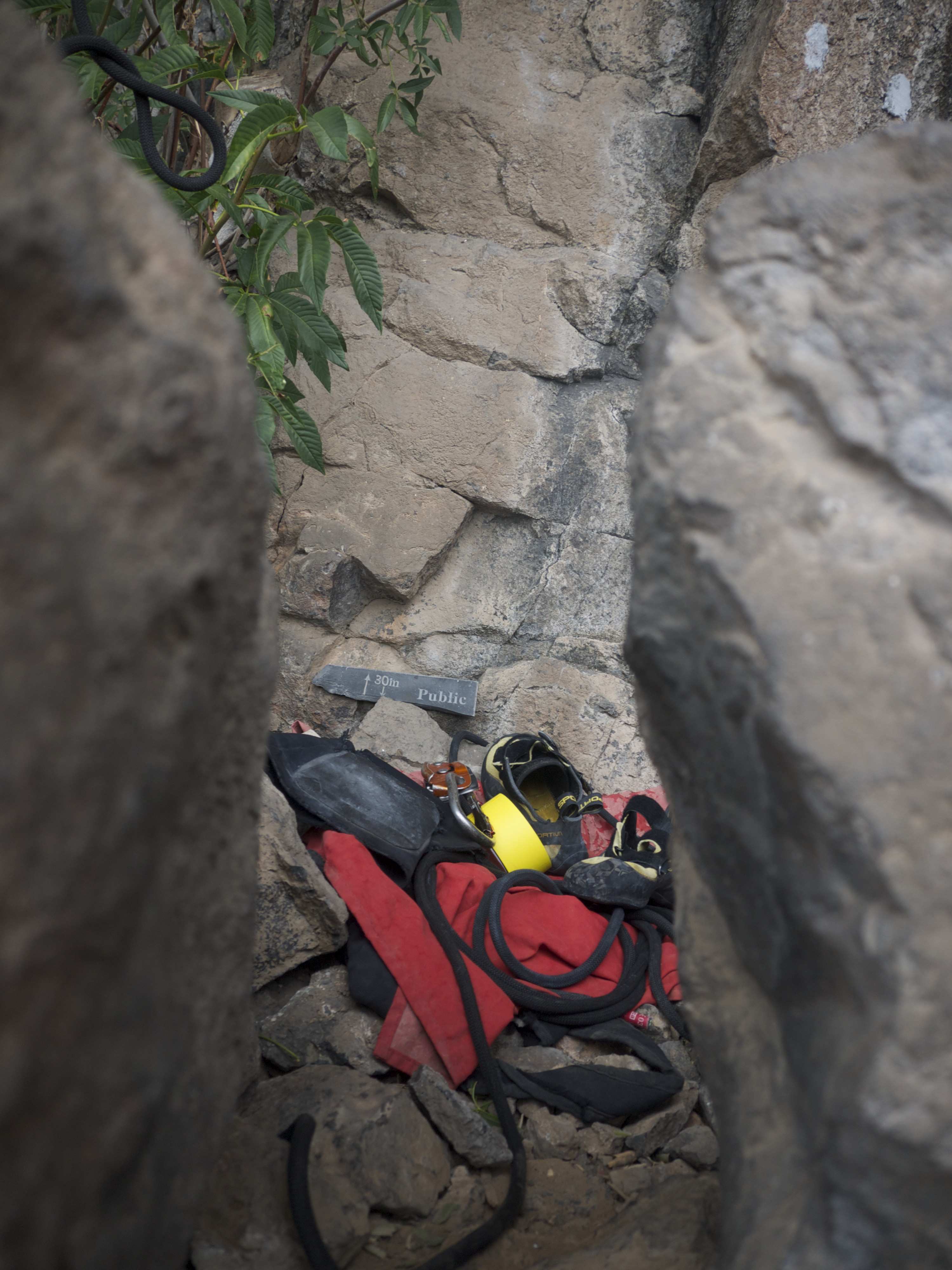Sonora’s Gold Country contains an amazing variety of climbing from limestone bouldering to traditional basalt cracks to blocky sport climbing. Spring and fall are the best times to climb in Sonora but the overhanging rock of Jailhouse stays dry in even the most savage winter storm. In the summer, escaping the heat can be easy at the columns of the Grotto. With solid weather throughout the year and an awesome range of climbing, Sonora offers a perfect destination for a long weekend on the rocks.
Day 1 Columbia College Bouldering
The Gold Rush of 1940 unearthed a large amount of precious minerals in the Sierra Foothills. The hydraulic mining also uncovered a mother lode of highly compacted marble boulders near Columbia College in Sonora. The hundreds of problems in the labyrinth of boulders require body tension and a solid ability to climb on sloping holds in a wild setting. “It’s like walking through the Castle Grayskull,” said Kim Groebner, a Berkeley boulderer.

Triple Cracks (V6), which John Sherman described in The Stone Crusade as “possibly the best single limestone problem in the country” sits below the college. Great problems like The Gold Wall (V4), Lobster Claw (V4), and the All American Finger Crack (V2) reside just meters away. The high concentration of boulder problems requires a fair amount of navigating and Columbia College Bouldering by Dean Fleming helps significantly.
Poison oak guards many of the boulder problems at Columbia and remains an issue around Sonora. Be aware of what the plant like and remember even the leafless winter branches can cause an allergic reaction.
For more info also check out: Columbia Bouldering
Day 2 The Grotto

The Grotto features amazing basalt cracks and blocky sport climbing just outside of Lake Melones on Table Mountain. The BLM land trail outside of Jamestown takes climbers drops them thirty feet into a pit with routes surrounding them. With trad routes on one side and sport routes on another, the Grotto provides a perfect opportunity for climbing.
The classic compression route AC Devil Dog (5.10c) involves refrigerator style wrestling up a perfect double arête. Go With the Flow is a perfect 5.9 hand crack to warm up for Rawhide (5.10d). For those looking for more of a challenge, there are extensions that climb the basalt columns and into steeper terrain as well as short challenging routes surrounding the Grotto. There are a number of more moderate sport climbs as well that provide a great opportunity for the budding lead climber.
The Grotto stays much cooler than the area around it because of its recessed nature and offers a perfect summer escape.

Check the MountainProject page for online reference.
Day 3 Jailhouse
One of California’s best sport crags remained locked on private land for years until the Access Fund negotiated with landowners for permanent access. Now California climbers have nearly a hundred overhanging routes in a giant basalt amphitheater to keep them busy. The climbing at Jailhouse remains difficult with the easiest route being 5.11d and the average route checking in at 5.13.
Check out the power endurance route Fugitive (5.13a), the sustained Alcatraz (5.13b) and the heart breaking ending of Jailbait (5.13c). Climbers in the 90s invented kneepads, sticking stealth climbing shoe rubber on neoprene pads, to help conquer the overhanging blocky terrain of Jailhouse. Once seen as a form of aid, kneepads are a standard and almost necessary part of climbing at Jailhouse.
Due to the easement agreement with landowners, a gate code is required to enter the park. Check in at the Access Fund website for the code.

For those that want to skip out on the hardman sport climbing, head back for another day of bouldering at Columbia, try more lines at the Grotto, or go swimming at Natural Bridges located off Parrots Ferry Road and across the bridge from Lake Melones.
How to Get There
Located in the Sierra foothills, Sonora sits two hours east of San Francisco. Follow the 580E to Highway 120, which merges with Highway 108 and heads directly into Sonora.
For the Columbia Boulders, drive north through Sonora on highway 49 for 2.3 miles. Head north on Parrots Ferry road for a tenth of a mile before turning east on Sawmill Mill Flat Road. Follow signs for 1.2 miles to Columbia College, and purchase a one-dollar student-parking pass. Campus maps will provide directions to the Lower Arboretum.
To get to the Grotto, drive southwest on highway 108 from Sonora towards Jamestown. Turn onto Rawhide road and drive west for two miles before turning south on Shell Road. Drive through two horse gates with a high clearance vehicle at the end of Shell Road or park outside and the gate and walk to the BLM parking area and pit toilet.
Park in student parking Rawhide to shell and a couple horse gates you can park outside the horse gates
To get to Jailhouse, follow the 108 south for 8 miles, turn west on O’Byrne’s Ferry Rd/ CO Rd E15, this is less than a mile after the Yosemite Junction, where Highways 108 and 120 diverge. Drive 3.7 miles and turn right at a double gate. Enter the gate code and close the gate behind the vehicle. Do not park outside this gate at any time, as the owner does not want to draw attention to this gate. Turn left and follow the dirt road ¼ of a mile to a fenced parking area on the right and close the gate after entry. Horses graze the land surrounding Jailhouse. Be considerate of the animals.
Where to Stay
First settled in 1848 by Mexican miners, Sonora remains a bit of a rough and tumble town with a historic feeling. Century old brick buildings line downtown. The town offers modern conveniences and provides a solid feel of California Gold Rush times.
The Sonora Inn in downtown offers nice hotel rooms ranging from $60 to $80 a night.
Tuttle Town Campground, located above Lake Melones, charges a more modest $22 and provides flush toilets, showers, drinking water, picnic tables and fire rings at each campsite. Bring a tent and sleeping bag for the car camping there.
What to Bring
A crash pad or two would be ideal for bouldering around Columbia College. For the roped climbing, a sixty-meter rope, climbing shoes, harness, belay device, and a set of quick draws will get you up the majority of the routes at the Grotto. A double set of cams and some stoppers will help with the traditionally protected routes. A seventy-meter rope will allow you to lower off most routes at Jailhouse. Bring kneepads for the overhanging rock. 90% of the routes are fixed and only a dog draw is necessary.
Wear lightweight long pants as the Sonora area has a significant amount of poison oak.
Sierra Nevada Adventure Company, located on Washington Street in downtown Sonora, offers great supplies for climbers and hikers. SNAC sells copies of A Climber’s Guide to Sonora Pass by Brad Young, which offers route topos to the Grotto, Columbia College Bouldering by Dean Fleming provides navigation for the limestone bouldering, and Bay Area Rock by Jim Thornburg contains an overview of each area as well as the only topo to Jailhouse.
Food & Drink
The Diamondback Grill, located on Washington Street in downtown Sonora, offers steak, salmon, great burgers, vegetarian options, and the best dining around the area. Mellow with a solid range of beer and wine options, The Diamondback Grill provides a perfect post climb dinner. Washington Street’s Bagel Bin provides great breakfast sandwiches, bagels, and coffee. A few Mexican restaurants dot Sonora and C & C’s taqueria in Jamestown offers cheap eats near the Grotto. Groceries and supplies can be purchased at the grocery stores in Sonora.
The Quick & Dirty
Where to Climb: The Grotto
Where to Stay: Tuttletown Campground
Where to Eat: Diamondback Grill

